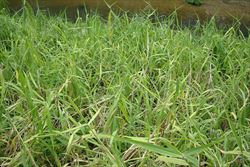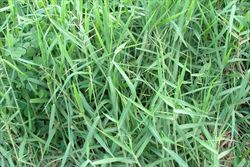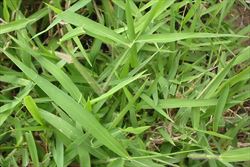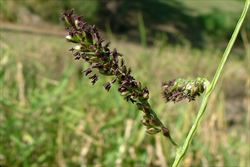Click on images to enlarge

dense infestation (Photo: Sheldon Navie)

habit (Photo: Sheldon Navie)

habit growing in water (Photo: Sheldon Navie)

habit in flower (Photo: Sheldon Navie)

stems and leaves (Photo: Sheldon Navie)

leaves (Photo: Sheldon Navie)

close-up of stem, leaf sheaths and leaf base (Photo: Sheldon Navie)

seed-head (Photo: Sheldon Navie)

seed-head branches (Photo: Sheldon Navie)

close-up of flower spikelets (Photo: Sheldon Navie)
Scientific Name
Urochloa mutica (Forssk.) Nguyen
Synonyms
Brachiaria mutica (Forssk.) StapfPanicum muticum Forssk.
Family
Gramineae (South Australia)Poaceae (Queensland, New South Wales, the ACT, Victoria, Tasmania, Western Australia and the Northern Territory)
Common Names
buffalo grass, California grass, Dutch grass, giant couch, Mauritius grass, panicum grass, para grass, Scotch grass, signal grass
Origin
Probably native to the tropical regions of Africa, but now found throughout the tropical and sub-tropical regions of the world (i.e. it has a pan-tropical distribution).
Cultivation
This plant was introduced as a pasture grass and is widely cultivated for this purpose in the warmer regions of Australia. It is very tolerant of waterlogged conditions and is mostly planted in ponded pastures.
Naturalised Distribution
Widely naturalised in the northern and eastern parts of Australia, particularly in coastal areas. It is most common along the east coast, from northern New South Wales through to northern Queensland. Relatively common in the northern regions of Western Australia and in the Northern Territory, and recorded from south-western Western Australia and inland Queensland.
Also naturalised on Christmas Island and widely naturalised overseas in Asia, New Zealand, USA (including Hawaii), Mexico, Central America, South America, the Caribbean, and on several Pacific islands.
Habitat
A weed of damp situations in the warmer temperate, sub-tropical and tropical regions of Australia. It is particularly abundant along creeks, on floodplains, in wetlands, along drainage channels, around lakes and dams, in roadside ditches and in other damp habitats, but is also occasionally a weed of summer crops, plantation crops (e.g. sugar cane), sown pastures and orchards.
Habit
A long-lived (i.e. perennial) grass with an upright (i.e. erect or ascending) habit, but also producing runners (i.e. stolons). It usually grows 0.25-1.25 m tall, but can sometimes grow up to 2 m or more in height.
Distinguishing Features
- a large grass growing up to 2 m or more tall that is mainly found growing in wetter habitats.
- it has densely hairy stem joints and leaf stalks.
- its seed-heads have numerous (5-20) branches and sometimes have the appearance of an open panicle.
- these seed-head branches occasionally have small side-branches and reduce in size towards the top of the seed-head.
- the oval-shaped flower spikelets are hairless and usually have purplish or blackish coloured stamens and stigmas.
Stems and Leaves
The flowering stems (i.e. culms) are upright (i.e. erect or ascending), sometimes exceeding 2 m in height. They may be branched and roots (i.e. adventitious roots) are often produced at the lower joints (i.e. basal nodes). The stem joints (i.e. nodes) are usually densely hairy (i.e. densely pubescent).
The leaves consist of a sheath that encloses the stem and a spreading leaf blade. Leaf sheaths are sparsely to densely hairy (i.e. puberulent to densely pubescent), and these hairs usually have a wart-like swelling at their bases (i.e. tuberculose hairs). Where the leaf sheath meets the leaf blade there is a line of hairs (i.e. a ciliated ligule) about 1.5 mm long or a tiny membranous flap topped with hairs (i.e. a ciliated membrane). The leaf blades are very narrow (i.e. linear) with entire margins and gradually narrow to a pointed tip (i.e. acute apex). These leaf blades (15-30 cm long and 3-20 mm wide) can be either hairless (i.e. glabrous) or somewhat hairy (i.e. pubescent).
Flowers and Fruit
The seed-heads (i.e. inflorescences) consist of 5-20 branchlets (i.e. racemes), each bearing numerous flower spikelets. These seed-head branches (2-13 cm long) are borne along the top 7-30 cm of the flowering stem and they gradually become reduced in size towards the top of the seed-head. The seed-head branches (i.e. racemes) are occasionally also slightly branched, with the secondary branches each carrying 3-6 flower spikelets, and this sometimes give the seed-head the appearance of an open panicle. Individual flower spikelets (2.5-3.5 mm long) are oval (i.e. elliptic) in shape and mostly hairless (i.e. glabrous). They consist of two greenish or purplish bracts (i.e. glumes) and two tiny flowers (i.e. florets). The lower floret only has male parts, while the upper floret has both male and female parts and produces the seed (i.e. it is fertile). Each floret has two pale green or whitish bracts (i.e. a palea and a lemma) and three purplish or blackish stamens, and the fertile floret also has an ovary topped with a feathery two-branched stigma. It flowers sporadically throughout the year, but mostly during summer and autumn (i.e. from November to May).
The flower spikelets turn brown or straw-coloured as they mature and the seeds (i.e. grains or caryopses) remain hidden inside them. These mature flower spikelets are shed from the seed-head intact, leaving only the bare seed-head branches behind (which often become somewhat curled as they age).
Reproduction and Dispersal
This species reproduces by seed and vegetatively via its creeping stems (i.e. stolons). It spreads laterally by these creeping stems (i.e. stolons) and can quickly cover large areas. Seeds and stem segments can be spread by floods and animals, and most long-distance dispersal occurs through its use as a pasture grass.
Environmental Impact
Para grass (Urochloa mutica) is regarded as a significant environmental weed in Western Australia, the Northern Territory and Queensland, and as an environmental weed some parts of New South Wales. It is actively managed by community groups in Queensland and the Northern Territory and was recently listed as a priority environmental weed in three Natural Resource Management regions. In south-eastern Queensland it is regarded to be among the top 50 most invasive environmental weeds, while a recent survey also placed it among the top 100 most important environmental weeds in northern New South Wales.
This species has become a serious weed of native wetlands throughout northern Australia, where it destroys waterbird breeding habitats and replaces native vegetation along streams and in riparian zones. For example, it is destroying the breeding habitat of the magpie goose (Anseranas semipalmata) and reducing the ability of the this waterbird to feed in open water. It is also one of the major environmental weeds infesting the Alligator River floodplain in the Northern Territory and contributing to the decline of the endangered yellow chat (Epthianura crocea tunneyi ).
Para grass (Urochloa mutica) quickly develops into very dense infestations that smother riverbanks and also floats out over the water surface. By doing this it chokes out the native species and prevents the regeneration of more desirable plants. It also invades areas of disturbed remnant vegetation away from water, especially in coastal areas where there are suitable fertile soils. This species is regarded as the worst of the weedy aquatic grasses in the Townsville area in northern Queensland and is also listed as an undesirable plant in the Wet Tropics World Heritage Area. Para grass (Urochloa mutica) and other invasive weeds are choking Louisa Creek in Townsville at a number of sites and providing a barriers to fish migration. It is also a very serious weed of the ecologically important Mary River Conservation Reserve in the Northern Territory, where it is thought to be causing major impacts on biodiversity.
Other Impacts
This species can also change the fire regime, particularly in monsoonal wetland areas in the Northern Territory. During the dry season the aboveground portion of the grass dries out can carry very hot fires that kill native plants and animals that are not used to this ecological change. It can also severely impair the water carrying ability of streams, causing increased flooding in badly infested river systems.
Legislation
Not declared or considered noxious by any state government authorities.
Management
For information on the management of this species see the following resources:
- the Biosecurity Queensland Fact Sheet on this species, which is available online at http://www.dpi.qld.gov.au.
Similar Species
Para grass (Urochloa mutica) is relatively similar to signal grass (Urochloa decumbens) and St. Lucia grass (Urochloa brizantha). These species can be distinguished by the following differences:
- para grass (Urochloa mutica) has seed-heads with 5-20 branches (i.e. racemes) that are usually arranged around the flowering stem and become much smaller towards the tip of the stem. Its flower spikelets are irregularly arranged along the seed-head branches (i.e. they are not in distinct rows) and are hairless (i.e. glabrous).
- signal grass (Urochloa decumbens) has seed-heads with 2-7 branches (i.e. racemes) that are usually all arranged along one side of the flowering stem. The flowering stem is usually also slightly extended beyond the last branch of the seed-head. Its flower spikelets are arranged in two rows along the seed-head branches and are somewhat hairy (i.e. pubescent).
- St. Lucia grass (Urochloa brizantha) has seed-heads with 2-16 branches (i.e. racemes) that are usually all arranged along one side of the flowering stem. The flowering stem is usually also slightly extended beyond the last branch of the seed-head. Its flower spikelets are arranged in a single row along the seed-head branches and are hairless (i.e. glabrous).
It is also superficially similar to molasses grass (Melinis minutiflora) when not in flower. However, molasses grass (Melinis minutiflora) has very different reddish or purplish coloured seed-heads and its tiny flower spikelets are topped with slender awns.

